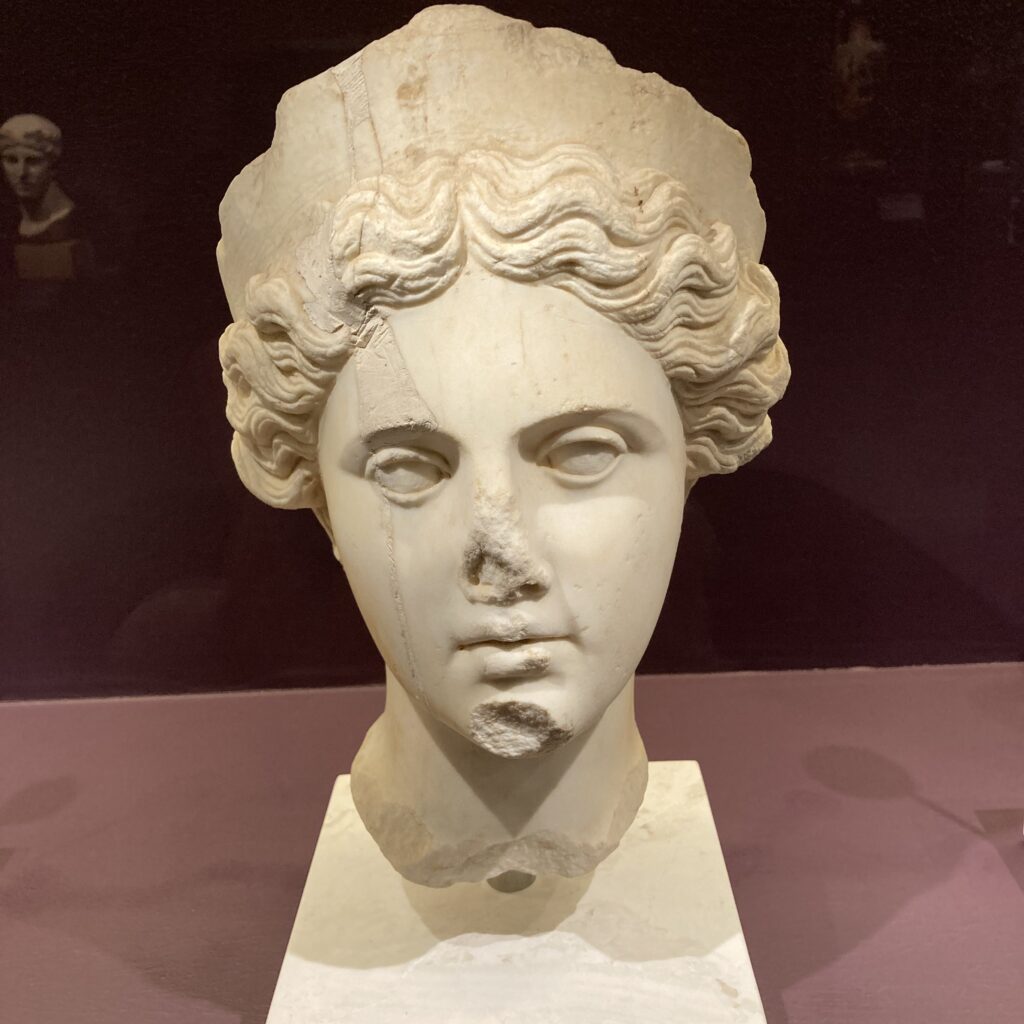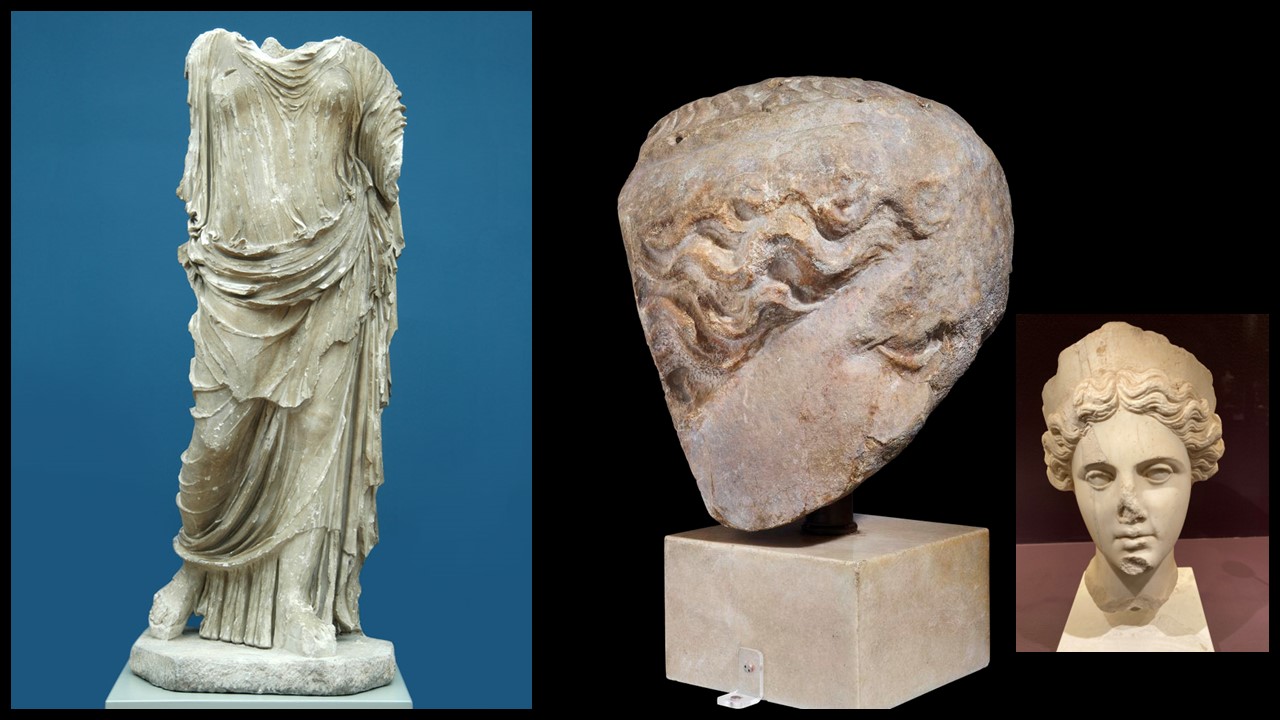
Of Nemesis we sing, undying goddess, stern Victory with spreading wings, infallible, seated by the throne of Justice; of thee that resentest man’s arrogance and sweepest it down to Tartarus… wrote Mesomedes of Crete, the Greek lyric poet and musician of the 2nd century AD, who served at the court of Emperor Hadrian. Standing before the Head of Nemesis from the Museum of ancient Agora in Athens I can almost feel the weight of divine retribution she carries, much like in Mesomedes’ Hymn to Nemesis, where she is invoked as the ever-watchful enforcer of balance, striking down human arrogance. https://laudatortemporisacti.blogspot.com/2008/07/mesomedes-hymn-to-nemesis.html
Goddess Nemesis in ancient Greek mythology was the personification of divine retribution and justice, often associated with the punishment of hubris (excessive pride or arrogance, in Greek Ύβρις). She was believed to maintain balance by ensuring that no individual, mortal or divine, grew too proud or overstepped moral boundaries. Nemesis was depicted as a stern and impartial force who imposed punishment on those who defied the natural order, often by bringing misfortune to those who had gained undeserved success or wealth.
Nemesis was traditionally viewed as a daughter of Nyx (Night), though her parentage varies in different accounts. She was also sometimes seen as an agent of fate, aligning her with themes of destiny and the unavoidable consequences of one’s actions. The goddess was often portrayed as a winged figure holding a sword, scales, or a wheel, symbolizing the cyclical nature of fortune and justice. https://www.perseus.tufts.edu/hopper/text?doc=Perseus%3Atext%3A1999.01.0130%3Acard%3D207
Worship of Nemesis was widespread, and she had a notable cult center at Rhamnous in Attica, where she was honored as a protector of justice. The temple at Rhamnous housed a large statue of the goddess, created by the sculptor Agorakritos, a student of Phidias, and was considered one of the finest representations of the goddess. Located near the fortress of Rhamnous, the temple symbolized her role as a guardian of law and order, watching over the region and its people, ensuring that justice was upheld in both mortal and divine realms.

Agorakritos of Paros, 5th century BC
Head of Nemesis, the personification of attribution of Justice, 430-420 BC, Marble, Height: 41.91 cm, British Museum, London, UK https://www.britishmuseum.org/collection/object/G_1820-0513-2
Head of Nemesis, the personification of attribution of Justice, 2nd century AD, Marble, Museum of Ancient Agora, Athens, Greece – Photo Credit: Amalia Spiliakou, February 18, 2024, ‘Meanings’. Personifications and Allegories from Antiquity to Today Exhibition, Acropolis Museum, Athens, Greece
The Statue of Nemesis by Agorakritos, a celebrated pupil of the renowned sculptor Phidias, was a masterpiece of classical Greek art housed in the temple of Rhamnous in Attica. Crafted in the 5th century BC, this statue depicted Nemesis as a stern, majestic figure embodying divine retribution and justice. Made from Parian marble, the statue was renowned for its exquisite detail and symbolic attributes, including a wreath, rein, and a branch, symbolizing punishment, control, and the restoration of balance.
After three years of meticulous research, Professor of Archaeology at Thessaloniki University, George Despinis, has made a significant breakthrough by assembling around 340 fragments of the Nemesis statue, supplementing the previously known head fragment held at the British Museum. While about one-fifth of the statue has been recovered, Despinis’ work goes beyond merely reconstructing this admired masterpiece. His analysis of the fragments has, for the first time, precisely revealed the unique style of Agorakritos, allowing him to identify parts of the Parthenon pediments and friezes created under the direction of Pheidias. https://www.penn.museum/sites/expedition/nemesis/
According to Pausanias and other sources, the Nemesis statue originated from a large marble slab that Datis, the Persian general under Darius, intended to use for a victory monument after defeating the Athenians during his campaign. However, following the Persian defeat at the Battle of Marathon, the Athenians discovered the massive slab abandoned on the battlefield. Based on Professor George Despinis’ calculations, the stone must have been nearly half the height of a Stonehenge monolith. Though the exact method of transporting the stone from Marathon to the Rhamnous sanctuary remains a mystery, it is widely believed that Agorakritos, a pupil of Pheidias, sculpted the statue, completing it by the onset of the Peloponnesian War, with its intricate pedestal and frieze finalized during the Peace of Nikias. https://www.the-athenian.com/site/1989/04/01/the-temples-of-rhamnous/
On February 17, 2024, during my visit to Athens, Greece, I had the pleasure of attending the exceptional exhibition titled ‘NοΗΜΑΤΑ’: Personifications and Allegories from Antiquity to Today, held at the Acropolis Museum. Curated by Professor Nikolaos Chr. Stampolidis and his associates, this exhibition formed a unique Tetralogy, wherein the Greek word ‘ΝΟΗΜΑ’ (‘Meaning’ in English) metaphorically transformed into ‘ΝΗΜΑ’ (‘Thread’), weaving together diverse artworks including statues, reliefs, vases, coins, jewelry, Byzantine icons, and paintings. Among the exhibition artworks that impressed me most was the 2nd-century AD marble Head of Nemesis, the personification of justice, displayed, currently, at the Museum of Ancient Agora in Athens, Greece. According to museum experts, this Head is one of many Roman copies of the original 5th-century statue by Agorakritos from Rhamnous, whose masterful work combined idealized beauty with the imposing presence of a goddess who embodied the consequences of human arrogance and excess.
For a Student Activity, please… Check HERE!